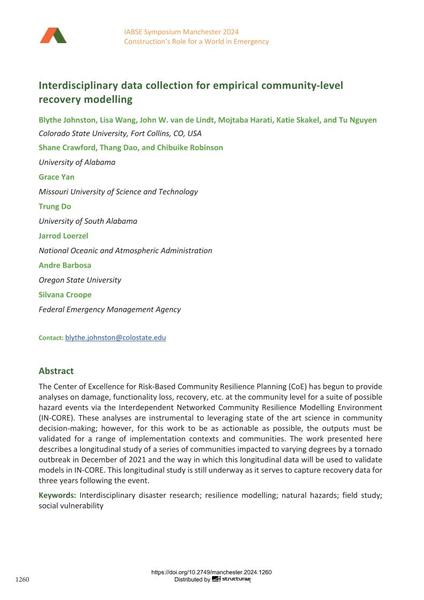Interdisciplinary data collection for empirical community-level recovery modelling

|
|
|||||||||||
Bibliographic Details
| Author(s): |
Blythe Johnston
(Colorado State University, Fort Collins, CO, USA Shane Crawford, Thang Dao, and Chibuike Robinson University of Alabama)
Lisa Wang (Colorado State University, Fort Collins, CO, USA Shane Crawford, Thang Dao, and Chibuike Robinson University of Alabama) John W. van de Lindt (Colorado State University, Fort Collins, CO, USA Shane Crawford, Thang Dao, and Chibuike Robinson University of Alabama) Mojtaba Harati (Colorado State University, Fort Collins, CO, USA Shane Crawford, Thang Dao, and Chibuike Robinson University of Alabama) Katie Skakel (Colorado State University, Fort Collins, CO, USA Shane Crawford, Thang Dao, and Chibuike Robinson University of Alabama) Shane Crawford (University of Alabama) Thang Dao (University of Alabama) Chibuike Robinson (University of Alabama) Grace Yan (Missouri University of Science and Technology) Trung Do (University of South Alabama) Jarrod Loerzel (National Oceanic and Atmospheric Administration) Andre Barbosa (Oregon State University) Silvana Croope (Federal Emergency Management Agency) |
||||
|---|---|---|---|---|---|
| Medium: | conference paper | ||||
| Language(s): | English | ||||
| Conference: | IABSE Symposium: Construction’s Role for a World in Emergency, Manchester, United Kingdom, 10-14 April 2024 | ||||
| Published in: | IABSE Symposium Manchester 2024 | ||||
|
|||||
| Page(s): | 1260-1267 | ||||
| Total no. of pages: | 8 | ||||
| DOI: | 10.2749/manchester.2024.1260 | ||||
| Abstract: |
The Center of Excellence for Risk-Based Community Resilience Planning (CoE) has begun to provide analyses on damage, functionality loss, recovery, etc. at the community level for a suite of possible hazard events via the Interdependent Networked Community Resilience Modelling Environment (IN-CORE). These analyses are instrumental to leveraging state of the art science in community decision-making; however, for this work to be as actionable as possible, the outputs must be validated for a range of implementation contexts and communities. The work presented here describes a longitudinal study of a series of communities impacted to varying degrees by a tornado outbreak in December of 2021 and the way in which this longitudinal data will be used to validate models in IN-CORE. This longitudinal study is still underway as it serves to capture recovery data for three years following the event. |
||||
| Keywords: |
natural hazards social vulnerability Interdisciplinary disaster research resilience modelling field study
|
||||
